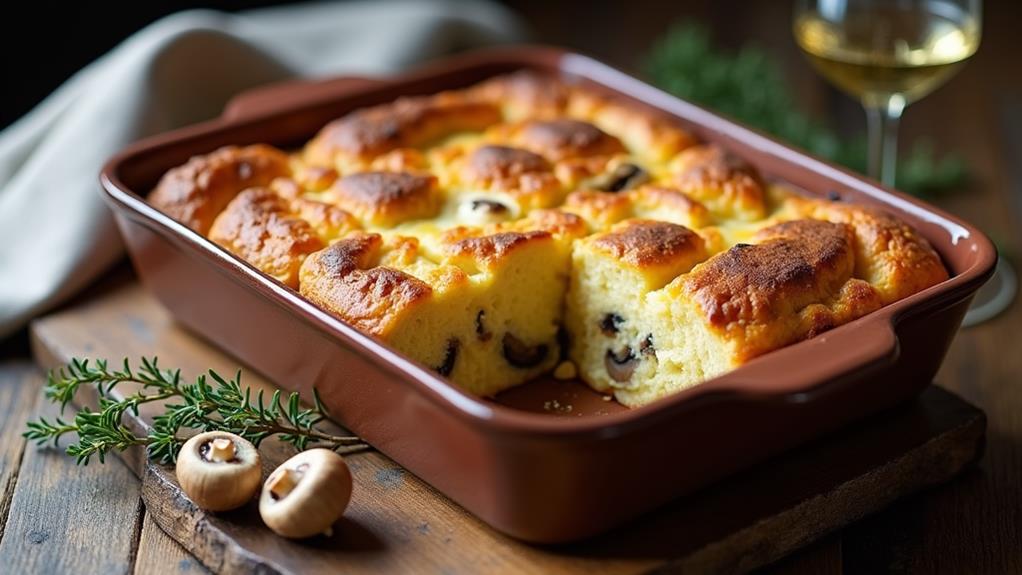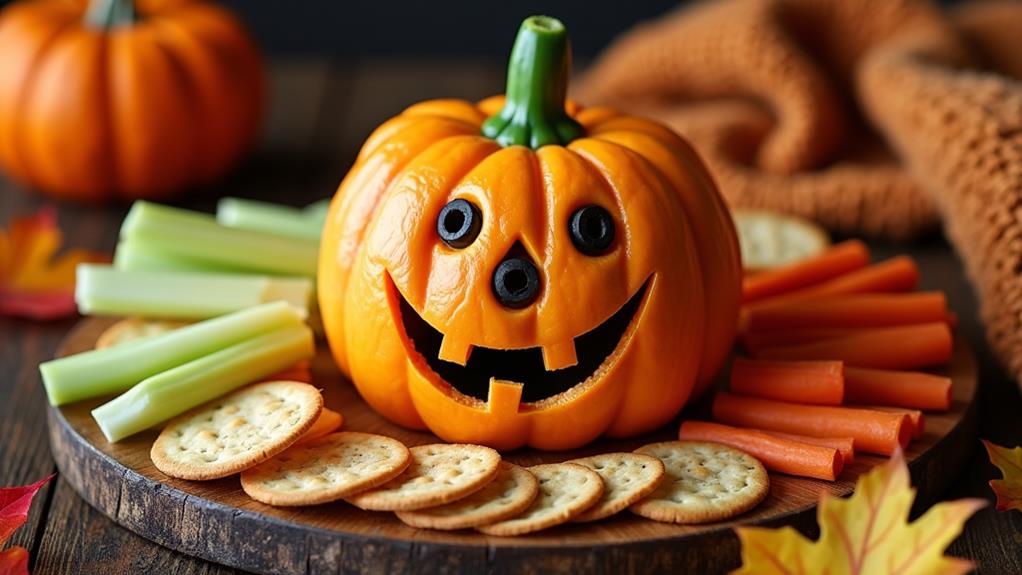You might think of bread pudding as a sweet dessert, but its savory counterpart can be equally enticing. When you combine crusty bread with earthy mushrooms, rich cheese, and a savory custard, you're in for a treat that's both comforting and sophisticated. This dish's versatility allows you to adapt it to your tastes or what's in your pantry. Whether you're looking for a hearty vegetarian main course or a unique side dish, savory bread pudding with mushrooms and cheese offers a delightful twist on a classic. But there's more to this dish than meets the eye…
Key Takeaways
- Savory bread pudding combines crusty bread, mushrooms, milk, eggs, and cheese for a rich, earthy flavor profile.
- Stale bread enhances custard absorption without becoming soggy, making it ideal for this dish.
- The recipe involves whisking eggs and milk, soaking bread cubes, adding mushrooms and cheese, then baking until golden brown.
- Bake at 350°F (175°C) for 40-45 minutes, checking for doneness with a knife and slight jiggle in the center.
- This versatile dish can be customized with various ingredients and served as a main course or side dish.
History
Bread pudding has a long and varied history, often dating back to medieval times. You'll find that this dish originated as a way to use up stale bread, preventing waste in an era when food was scarce. Initially, it was primarily a sweet dessert, but over time, savory versions emerged as cooks experimented with different ingredients.
In the Middle Ages, you'd have seen bread puddings made with milk, eggs, and whatever spices were available. As trade routes expanded, new flavors were introduced, leading to more diverse recipes.
By the 18th century, savory bread puddings had become popular in Europe, often incorporating meats, vegetables, and cheeses.
You'll notice that the dish evolved differently across cultures. In France, you might encounter pain perdu, while in England, bread and butter pudding became a staple.
The savory mushroom and cheese version you're learning about today is a modern interpretation of this classic dish. It reflects our contemporary taste for umami-rich flavors and the desire for hearty, comforting meals that are easy to prepare.
Recipe
Savory bread pudding is a comforting and versatile dish that transforms simple ingredients into a hearty meal. This mushroom and cheese version offers a delightful combination of earthy flavors and rich textures, perfect for brunch, lunch, or dinner.
This five-ingredient bread pudding is easy to prepare and can be customized to suit your taste preferences. The crusty bread soaks up the savory custard, while the mushrooms add depth and the cheese creates a golden, crispy top.
- 8 cups (480g) day-old crusty bread, cubed
- 2 cups (200g) sliced mushrooms
- 2 cups (240ml) milk
- 4 large eggs
- 2 cups (200g) shredded cheese (such as Gruyère or cheddar)
Preheat the oven to 350°F (175°C). In a large bowl, whisk together the milk and eggs. Add the bread cubes and let them soak for 10 minutes. Stir in the sliced mushrooms and half of the shredded cheese.
Transfer the mixture to a greased 9×13-inch (23x33cm) baking dish. Sprinkle the remaining cheese on top. Bake for 40-45 minutes, or until the top is golden brown and the center is set.
For the best results, use stale bread as it will absorb the custard better without becoming too soggy. If you only have fresh bread, you can dry it out in the oven at a low temperature for about 10 minutes before using.
Feel free to add herbs or spices to enhance the flavor profile of your bread pudding. Leftovers can be refrigerated for up to 3 days and reheated in the oven or microwave.
Cooking Steps
To prepare this savory bread pudding, you'll begin by preheating your oven to 350°F and whisking together milk and eggs in a large bowl.
Next, you'll add the bread cubes to this egg mixture, allowing them to soak for 10 minutes before stirring in the sliced mushrooms and half of the shredded cheese.
Once combined, transfer the mixture to a greased baking dish, sprinkle the remaining cheese on top, and bake until the pudding is golden brown and set in the center, which typically takes 40-45 minutes.
Step 1. Preheat Oven to 350°F

Before diving into the preparation, it's crucial to preheat your oven to 350°F (175°C). This step ensures that your savory bread pudding will cook evenly and achieve the perfect golden-brown crust.
While the oven is heating up, you'll have time to prepare the other ingredients and assemble the dish.
Don't underestimate the importance of proper oven temperature. If it's too low, your bread pudding might end up soggy and undercooked. On the other hand, if it's too high, you risk burning the top before the center is fully set.
To guarantee accuracy, use an oven thermometer if you have one available. It's not uncommon for ovens to be slightly off in their temperature calibration.
If you're using a convection oven, you might want to lower the temperature by about 25°F, as these ovens tend to cook food faster due to the circulating hot air.
Step 2. Whisk Milk and Eggs
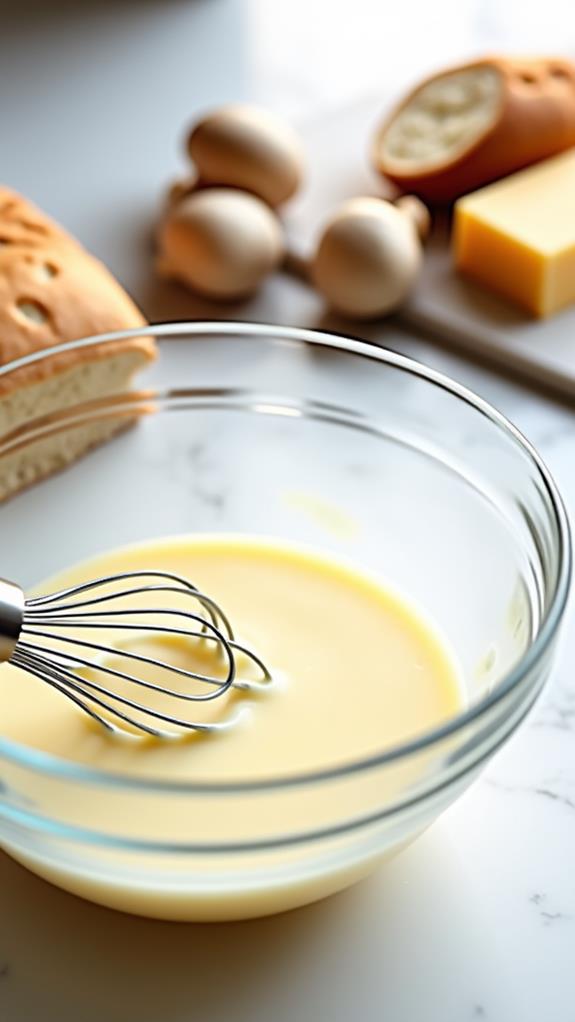
With your oven preheating, it's time to create the custard base for your savory bread pudding. In a large bowl, crack open four large eggs, ensuring no shell fragments slip in. Pour in two cups of milk, which will provide the creamy foundation for your dish.
Now, grab a whisk and begin to blend these ingredients together. As you whisk, you'll notice the mixture becoming smooth and homogeneous. It's crucial to whisk thoroughly, incorporating air into the custard to achieve a light, fluffy texture in your final product.
Don't rush this step; take your time to ensure the eggs and milk are fully combined. You'll know you're done when the mixture has a uniform pale yellow color and a slightly frothy appearance. This well-whisked custard will evenly coat your bread cubes, infusing them with rich flavor and moisture.
Once you've achieved the perfect consistency, set the bowl aside. You're now ready to move on to the next step in creating your delicious savory bread pudding with mushrooms and cheese.
Step 3. Add Bread to Egg Mixture
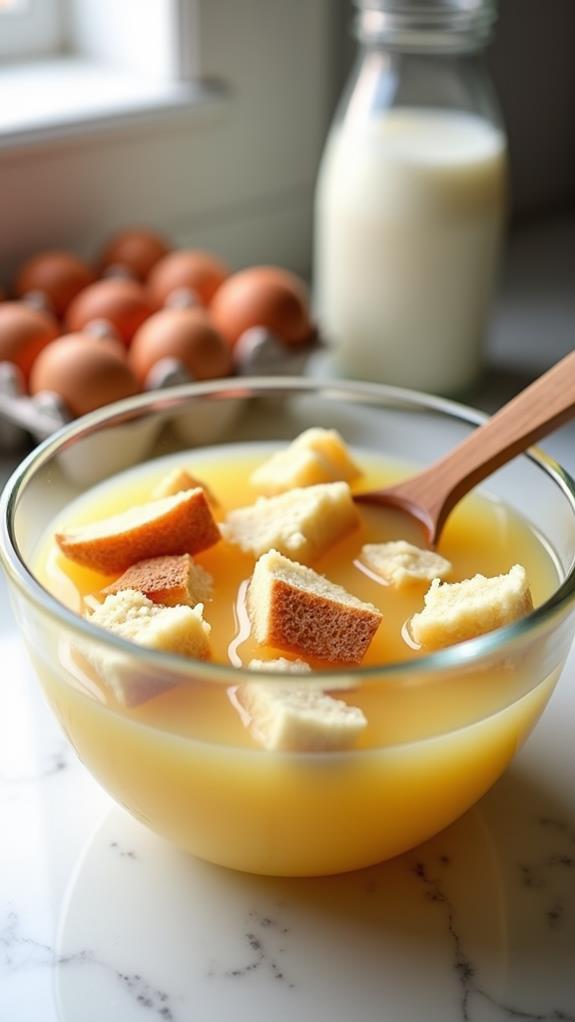
The next crucial step in your savory bread pudding journey is adding the bread cubes to your egg mixture. Once you've whisked together the milk and eggs, it's time to introduce the star of the show: the bread.
Take your 8 cups of day-old crusty bread cubes and gently fold them into the egg mixture. Ensure that each piece of bread is thoroughly coated, as this will allow it to absorb the flavorful custard.
After you've combined the bread and egg mixture, it's essential to let it sit for about 10 minutes. This resting period allows the bread to soak up the liquid, resulting in a more cohesive and flavorful pudding.
During this time, you'll notice the bread softening and expanding as it absorbs the custard. Don't worry if some pieces seem drier than others; they'll even out during baking.
If you find that your mixture looks too dry, you can add a splash more milk to ensure proper consistency. Remember, the goal is to have moist, custard-soaked bread that will bake into a delicious, savory pudding.
Step 4. Stir in Mushrooms and Cheese
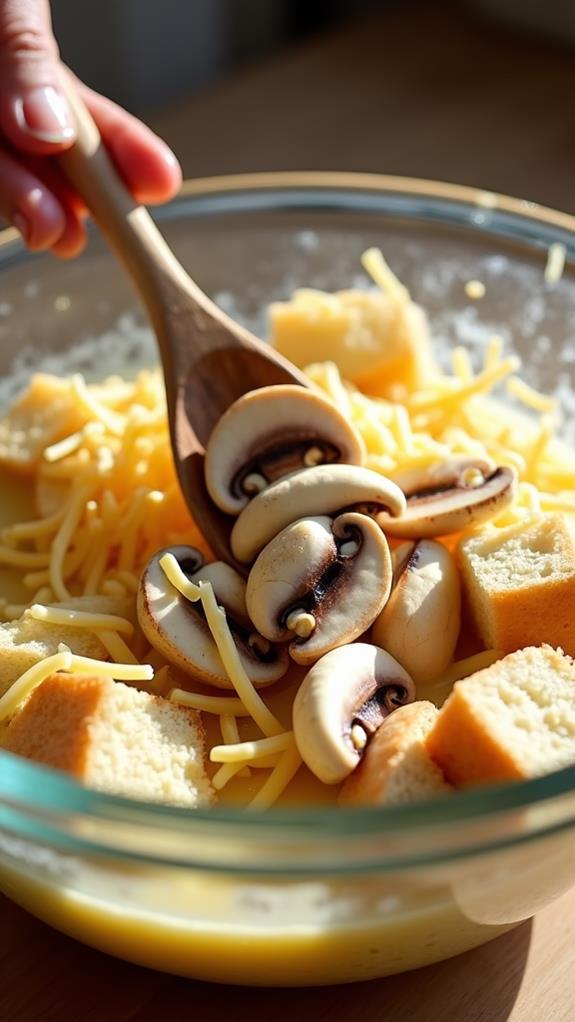
After the bread has soaked up the custard, it's time to add the flavorful mix-ins. Grab your sliced mushrooms and shredded cheese, as these ingredients will elevate your bread pudding to new heights of savory goodness.
Begin by gently folding the sliced mushrooms into the bread mixture, ensuring they're evenly distributed throughout. The mushrooms will lend an earthy, umami flavor to the dish, complementing the rich custard base.
Next, you'll want to incorporate half of the shredded cheese into the mixture. This step is crucial, as it'll create pockets of melted cheese throughout the pudding, adding both flavor and texture.
Use a spatula or large spoon to fold the cheese in carefully, making sure it's well-distributed. Don't worry about being too precise; the random distribution will lead to delightful surprises in each bite.
Once you've mixed in the mushrooms and cheese, you're ready to transfer the entire mixture to your prepared baking dish.
Remember to reserve the remaining cheese for topping the pudding before it goes into the oven.
Step 5. Bake Until Golden Brown
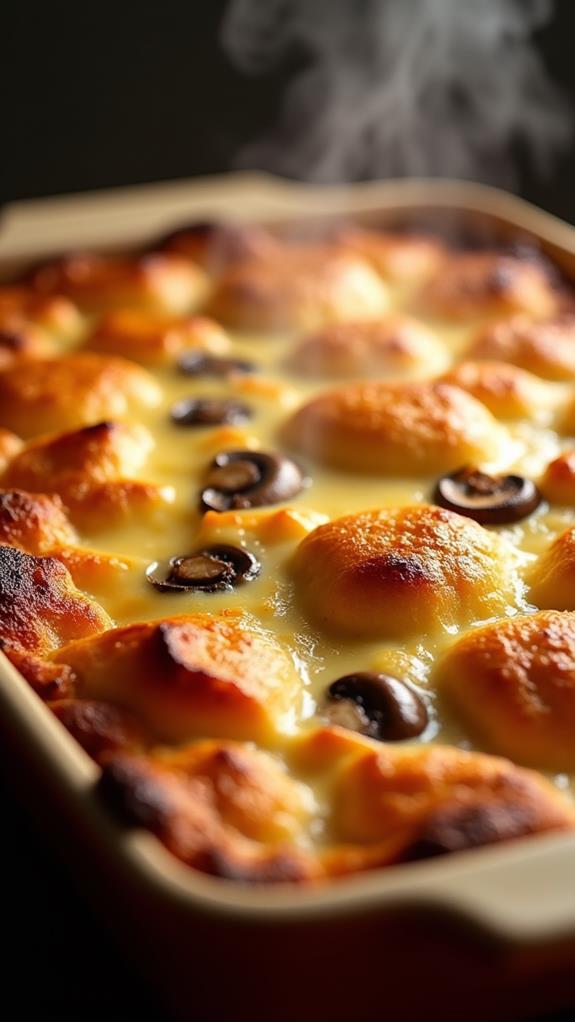
Now that you've assembled your savory bread pudding, it's time to bake it to perfection. Place the baking dish in your preheated oven, ensuring it's centered on the middle rack for even heat distribution. Set your timer for 40 minutes, but keep an eye on the pudding as it bakes. You're looking for a golden-brown top and a set center.
As the pudding bakes, you'll notice the enticing aroma of toasted bread and melting cheese filling your kitchen. The custard will slowly firm up, transforming the bread from soggy to delightfully tender.
Around the 30-minute mark, check on your pudding. If it's browning too quickly, cover it loosely with aluminum foil to prevent burning.
To test for doneness, gently shake the baking dish. The center should jiggle slightly but not appear liquid. If you're unsure, insert a knife into the middle; it should come out clean with no raw egg mixture.
Once perfectly baked, remove your bread pudding from the oven and let it cool for 5-10 minutes before serving. This cooling period allows the custard to set further, making it easier to slice and serve.
Final Thoughts
While savory bread pudding may seem intimidating at first, you'll find it's a versatile and forgiving dish that's perfect for experimenting with different flavors.
Don't be afraid to swap out ingredients based on what you have on hand or your personal preferences. Try using different types of bread, such as sourdough or whole grain, to add unique textures and tastes. You can also incorporate various vegetables, herbs, or even cooked meats to create your own signature version.
Remember that the key to a successful bread pudding lies in the balance between the bread and the custard. If your mixture seems too dry, add a bit more milk; if it's too wet, toss in some extra bread cubes.
As you become more comfortable with the basic recipe, you'll develop an intuition for achieving the perfect consistency. Serve your savory bread pudding as a main dish alongside a crisp salad, or as a satisfying side to complement roasted meats or vegetables.
With its endless possibilities and comforting appeal, this dish is sure to become a staple in your culinary repertoire.

